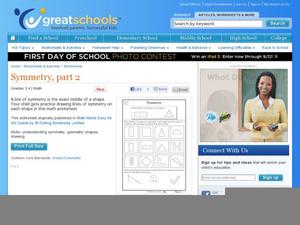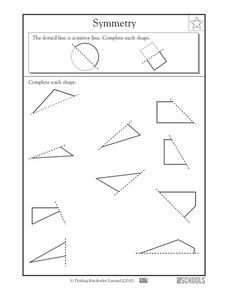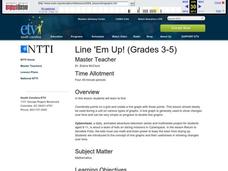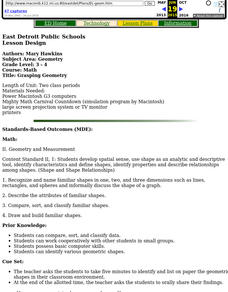Houghton Mifflin Harcourt
Unit 3 Math Vocabulary Cards (Grade 1)
Reinforce math vocabulary with a set of flashcards. Each card showcases a boldly typed word or a picture representation with labels. The topics are geometry related and include terms such as cones, faces, pyramids, sides, and...
Math Mammoth
Parallel & Perpendicular Lines
For this geometry learning exercise, 4th graders list the lines that are parallel or perpendicular to each other. Then they mark with one color the line segments that are parallel and another color those that are perpendicular.
Curated OER
Marshmallow Geometry
In this three-dimensional shapes geometry instructional activity, learners identify geometric solids and name their properties. They define "face," "edge," and "vertex," and construct geometric solids using marshmallows as vertices and...
Curated OER
Geometry - Angles Overview
Learners address 14 questions that include naming all pairs of opposite and supplementary angles for sets of intersecting lines and then, finding the measure of the unknown angle. They determine the measure of the angle that is...
K12 Reader
Basic Geometry Terms
Set your pupils up to start on geometry by teaching them some introductory terminology. Pupils learn the terms by reading a short passage and looking at examples. They then respond to five questions related to the text.
Curated OER
Origami Ducks: Geometry, Listening, and Following Directions
Make origami ducks with your class to reinforce geometry concepts and vocabulary; develop fine motor and visual translation skills; and enrich study of Japanese culture, the pond habitat, or migration. Create a whole group "worksheet"...
Curated OER
Symmetry, Part 2
How can you tell if shapes are symmetrical? Fourth graders study 12 shapes, and draw lines down the middle of shapes that have symmetry. Once they are finished, they complete shapes that are missing their symmetrical sides. Some shapes...
Curated OER
Symmetry
Enhance your geometry lesson by working with shapes. Fourth graders follow lines of symmetry to complete ten shapes, most of them currently triangles. Have pupils color each half of their shapes to reinforce the idea of symmetry!
Curated OER
Line 'Em Up!
Young scholars find coordinate points on a grid and create a line graph with those points. This lesson should ideally be used during a unit on various types of graphs. They make and use coordinate systems to specify locations and to...
Curated OER
Properties of Lines - Parallel and Perpendicular
Sixth graders identify parallel and perpendicular lines in the alphabet. In this line properties lesson, 6th graders use the letters of the alphabet to show parallel and perpendicular lines. Students open a Geogrid Mat on the computer...
Curated OER
Geometry and Quilting
Fourth graders combine geometry and language arts skills while examining quilt-making. After identifying the geometric shapes contained in quilts, they write stories to encompass the quilt border. Students conclude by creating and...
Curated OER
Hoops: Grade 4 and 5
4th-5th graders will compete in a game similar to Jeopardy in which they answer questions from a variety of subject areas including science, language, and math. The questions are based on an extremely wide variety of topics, so would be...
Curated OER
Design a Colonial Garden
Students explore botany by completing an art design activity in class. In this gardening history lesson, students identify the plants and crops utilized in the Colonial era for both food and medicine. Students utilize geometry to create...
Curated OER
Geometry of Democracy
Learners explore the architecture of New England by identifying geometric shapes. In this architectural lesson, students examine photographs of classic building architecture and use a transparency to trace geometric shapes they...
Curated OER
Hoops
With a creative premise involving a basketball competition, this game could be used to review basic science, grammar and math concepts in a fourth or fifth grade classroom. It is a fun idea, and a motivating way to review information....
Pennsylvania Department of Education
What's My Height?
Students explore geometry by conducing a student measurement activity. In this height lesson, students identify their own height by utilizing a tape measure and marking their height on a wall. Students identify their height in...
Curated OER
Mr. Bo Jangle, What's Your Angle?
Third graders explore angles. In this geometry lesson plan, 3rd graders identify and define acute, obtuse, and right angles. Students form angles with their bodies, find angles in picture books, and record angles found outside in their...
Curated OER
Hello My Name is . . . Helvetica
Students play various games to help create a classroom community. In this name recognition lesson, students combine their name recognition skills with newly learned art and geometric vocabulary. First students discover vocabulary that...
Curated OER
Archaeology: Digging in the Classroom
Learners explore how an archaeologist works and makes discoveries. In this archaeology lesson, students participate in a simulation in which they excavate broken pottery. Learners use measurement, geometry, and observation skills during...
Curated OER
Find Someone
Your class will participate in a series of math vocabulary activities to learn about parallel lines. They find people using a math list and connect math words in the context of sentences. They also read the math words in the example...
K12 Reader
Kinds of Angles
Have you ever wondered how circles and angles relate to each other? Read a passage about right angles, acute angles, and obtuse angles, and answer reading comprehension questions about the information you learn.
Curated OER
Grasping Geometry
Students investigate geometric shapes in their environment, make a geometric design, and write paragraphs describing the design.
Curated OER
Geometry House!
Fourth graders use computer drawing tools to create a house of geometric shapes.
Curated OER
Mazes and Labyrinths
Pupils evaluate directions by participating in a maze activity. In this labyrinth activity, students identify the history of mazes and labyrinths and utilize Google Earth to examine real life mazes. Pupils create their own mazes...























